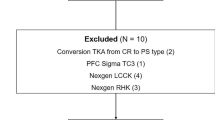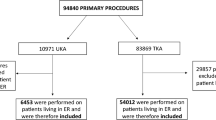Abstract
Purpose
Revision total knee arthroplasty (rTKA) is a complex procedure. Depending on the degree of ligament and bone damage, either primary or revision implants are used. The purpose of this study was to compare survival rates of primary implants with revision implants when used during rTKA.
Methods
A retrospective comparative study was conducted between 1998 and 2009 during which 69 rTKAs were performed on 65 patients. Most common indications for revision were infection (30 %), aseptic loosening (25 %) and wear/osteolysis (25 %). During rTKA, a primary implant was used in nine knees and a revision implant in 60.
Results
Survival of primary implants was 100 % at one year, 73 % [95 % confidence interval (CI) 41–100] at two years and 44 % (95 % CI 7–81) at five years. Survival of revision implants was 95 % (95 % CI 89–100) at one year, 92 % (95 % CI 84–99) at two years and 92 % (95 % CI 84–99) at five years. Primary implants had a significantly worse survival rate than revision implants when implanted during rTKA [P = 0.039 (hazard ratio = 4.56, 95 % CI 1.08–19.27)].
Conclusions
Based on these results, it has to be considered whether primary implants are even an option during rTKA.


Similar content being viewed by others
References
Kurtz S, Mowat F, Ong K, Chan N, Lau E, Halpern M (2005) Prevalence of primary and revision total hip and knee arthroplasty in the united states from 1990 through 2002. J Bone Joint Surg Am 87:1487–1497. doi:10.2106/JBJS.D.02441
Kurtz SM, Ong KL, Lau E, Widmer M, Maravic M et al (2011) International survey of primary and revision total knee replacement. Int Orthop 35:1783–1789. doi:10.1007/s00264-011-1235-5
Nevalainen J, Keinonen A, Mäkelä A, Pentti A (2003) The 2002–2003 implant yearbook on orthopaedic endoprostheses: Finnish arthroplasty register. helsinki, finland: National agency for medicines. www.nam.fi/uploads/julkaisut/Orthopaedic_endoprostheses_2003_v.pdf
Kurtz S, Ong K, Lau E, Mowat F, Halpern M (2007) Projections of primary and revision hip and knee arthroplasty in the united states from 2005 to 2030. J Bone Joint Surg Am 89:780–785. doi:10.2106/JBJS.F.00222
Bryan RS, Rand JA (1982) Revision total knee arthroplasty. Clin Orthop Relat Res 170:116–122
Whiteside LA (1993) Cementless revision total knee arthroplasty. Clin Orthop Relat Res 286:160–167
Hwang SC, Kong JY, Nam DC, Kim DH, Park HB, Jeong ST, Cho SH (2010) Revision total knee arthroplasty with a cemented posterior stabilized, condylar constrained or fully constrained prosthesis: a minimum 2-year follow-up analysis. Clin Orthop Surg 2:112–120. doi:10.4055/cios.2010.2.2.112
Morgan H, Battista V, Leopold SS (2005) Constraint in primary total knee arthroplasty. J Am Acad Orthop Surg 13:515–524
Peters CL, Hennessey R, Barden RM, Galante JO, Rosenberg AG (1997) Revision total knee arthroplasty with a cemented posterior-stabilized or constrained condylar prosthesis: a minimum 3-year and average 5-year follow-up study. J Arthroplasty 12:896–903
Scuderi GR (2001) Revision total knee arthroplasty: how much constraint is enough? Clin Orthop Relat Res 392:300–305
Pour AE, Parvizi J, Slenker N, Purtill JJ, Sharkey PF (2007) Rotating hinged total knee replacement: use with caution. J Bone Joint Surg Am 89:1735–1741. doi:10.2106/JBJS.F.00893
Sculco TP (2006) The role of constraint in total knee arthoplasty. J Arthroplasty 21:54–56. doi:10.1016/j.arth.2006.02.166
Hartford JM, Goodman SB, Schurman DJ, Knoblick G (1998) Complex primary and revision total knee arthroplasty using the condylar constrained prosthesis: an average 5-year follow-up. J Arthroplasty 13:380–387
Callaghan JJ, O’Rourke MR, Liu SS (2005) The role of implant constraint in revision total knee arthroplasty: not too little, not too much. J Arthroplasty 20:41–43
Cuckler JM (1995) Revision total knee arthroplasty: how much constraint is necessary? Orthopedics 18(932–3):936
Gustke KA (2005) Preoperative planning for revision total knee arthroplasty:avoiding chaos. J Arthroplasty 20:37–40
Mulhall KJ, Ghomrawi HM, Engh GA, Clark CR, Lotke P, Saleh KJ (2006) Radiographic prediction of intraoperative bone loss in knee arthroplasty revision. Clin Orthop Relat Res 446:51–58. doi:10.1097/01.blo.0000214438.57151.a5
Sheng PY, Konttinen L, Lehto M, Ogino D, Jamsen E, Nevalainen J, Pajamaki J, Halonen P, Konttinen YT (2006) Revision total knee arthroplasty: 1990 through 2002. A review of the finnish arthroplasty registry. J Bone Joint Surg Am 88:1425–1430. doi:10.2106/JBJS.E.00737
Meding JB, Wing JT, Ritter MA (2011) Does high tibial osteotomy affect the success or survival of a total knee replacement? Clin Orthop Relat Res 469:1991–1994. doi:10.1007/s11999-011-1810-5
Ranawat CS, Flynn WF Jr, Deshmukh RG (1994) Impact of modern technique on long-term results of total condylar knee arthroplasty. Clin Orthop Relat Res 309:131–135
Cox DR (1972) Regression models and life-tables. J R Stat Soc Series B 34:182–202
Rand JA, Bryan RS (1982) Revision after total knee arthroplasty. Orthop Clin North Am 13:201–212
Goldberg VM, Figgie MP, Figgie HE 3rd, Sobel M (1988) The results of revision total knee arthroplasty. Clin Orthop Relat Res 226:86–92
Cameron HU, Hunter GA (1982) Failure in total knee arthroplasty: mechanisms, revisions, and results. Clin Orthop Relat Res 170:141–146
Hanssen AD, Rand JA (1988) A comparison of primary and revision total knee arthroplasty using the kinematic stabilizer prosthesis. J Bone Joint Surg Am 70:491–499
Barrack RL, Engh G, Rorabeck C, Sawhney J, Woolfrey M (2000) Patient satisfaction and outcome after septic versus aseptic revision total knee arthroplasty. J Arthroplasty 15:990–993. doi:10.1054/arth.2000.16504
Deehan DJ, Murray JD, Birdsall PD, Pinder IM (2006) Quality of life after knee revision arthroplasty. Acta Orthop 77:761–766. doi:10.1080/17453670610012953
Wang CJ, Hsieh MC, Huang TW, Wang JW, Chen HS, Liu CY (2004) Clinical outcome and patient satisfaction in aseptic and septic revision total knee arthroplasty. Knee 11:45–49. doi:10.1016/S0968-0160(02)00094-7
Mortazavi SM, Molligan J, Austin MS, Purtill JJ, Hozack WJ, Parvizi J (2011) Failure following revision total knee arthroplasty: infection is the major cause. Int Orthop 35:1157–1164. doi:10.1007/s00264-010-1134-1
Zywiel MG, Johnson AJ, Stroh DA, Martin J, Marker DR, Mont MA (2011) Prophylactic oral antibiotics reduce reinfection rates following two-stage revision total knee arthroplasty. Int Orthop 35:37–42. doi:10.1007/s00264-010-0992-x
Engh GA, Ammeen DJ (1999) Bone loss with revision total knee arthroplasty: defect classification and alternatives for reconstruction. Instr Course Lect 48:167–175
Robertsson O, Ranstam J (2003) No bias of ignored bilaterality when analysing the revision risk of knee prostheses: analysis of a population based sample of 44,590 patients with 55,298 knee prostheses from the national Swedish Knee Arthroplasty register. BMC Musculoskelet Disord 4:1
Conflict of interest
Drs. A.L. Boerboom is a paid consultant for Zimmer GmbH for training in knee arthroplasty and computer-assisted surgery. The department receives research institutional support from Stryker and Zimmer. The other authors declare that they have no conflict of interest.
Author information
Authors and Affiliations
Corresponding author
Rights and permissions
About this article
Cite this article
Meijer, M.F., Reininga, I.H.F., Boerboom, A.L. et al. Poorer survival after a primary implant during revision total knee arthroplasty. International Orthopaedics (SICOT) 37, 415–419 (2013). https://doi.org/10.1007/s00264-012-1739-7
Received:
Accepted:
Published:
Issue Date:
DOI: https://doi.org/10.1007/s00264-012-1739-7




